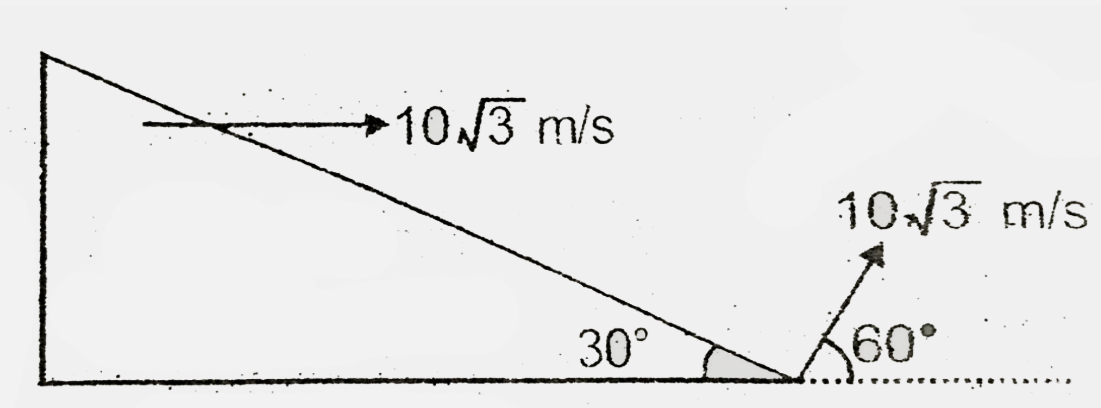A particle is projected at an angle 60∘ with speed 10√3 m/s from the point A as shown in the figure. At the same time the wedge is made to move with speed 10√3 m/s toward right as shown in figure. Find the time after which particle will strike the wedge.

The correct Answer is:t = 2 seconds
Step by step video & image solution for A particle is projected at an angle 60^(@) with speed 10sqrt3 m/s from the point A as shown in the figure. At the same time the wedge is made to move with speed 10sqrt3 m/s toward right as shown in figure. Find the time after which particle will strike the wedge. by Physics experts to help you in doubts & scoring excellent marks in Class 12 exams.
Updated on:21/07/2023Topper's Solved these Questions
- MOTION IN A PLANEBOOK - AAKASH INSTITUTECHAPTER - MOTION IN A PLANEEXERCISE - Assignement section -H (Multiple True-False)
1 Videos
- MOCK_TEST_17BOOK - AAKASH INSTITUTECHAPTER - MOCK_TEST_17EXERCISE - Example
15 Videos
- MOTION IN A STRAIGHT LINEBOOK - AAKASH INSTITUTECHAPTER - MOTION IN A STRAIGHT LINEEXERCISE - ASSIGNMENT (SECTION - D)
15 Videos
Similar Questions
Particle projected from tower fo heigh 10m as shown in figure. Find the time (in sec) after which particle will hit the ground.

View SolutionA ball is projected at an angle 45∘ as shown with speed 20√2m/s at t=0. At the same time wedge is made to move with velocity 40m/s in the direction shown, If the time at which the ball hits the wedge is √xcos15∘ then value of x is

View Solution
Knowledge Check
A particle is projected at an angle 60∘ with speed 10(√3)m/s, from the point A, as shown in the figure. At the same time the wedge is made to move with speed 10(√3)m/s towards right as shown in the figure. Then the time after which particle will strike with wedge is
 A2 sB2(sqrt3) sC4√3sDNone of these
A2 sB2(sqrt3) sC4√3sDNone of theseTwo particles are projected with speed 4m/s and 3m/s simultaneously from same point as shown in the figure. Then :
 ATheir relative velocity is along horizontal direction.BTheir relative acceleration is non-zero and it is along vertical direction.CThey will hit the surface simultaneously.DTheir relative velocity is constant and has magnitude 1.4m/s
ATheir relative velocity is along horizontal direction.BTheir relative acceleration is non-zero and it is along vertical direction.CThey will hit the surface simultaneously.DTheir relative velocity is constant and has magnitude 1.4m/sTwo particles are projected with speed 4m/s and 3m/s simultaneously from same point as shown in the figure. Then:
 ATheir relative velocity is along vertical directionBTheir relative acceleration is non-zero and it is along vertical directionCThey will hit the surface simultaneouslyDTheir relative velocity is constant and has magnitude 1.4m/s
ATheir relative velocity is along vertical directionBTheir relative acceleration is non-zero and it is along vertical directionCThey will hit the surface simultaneouslyDTheir relative velocity is constant and has magnitude 1.4m/s
A particle is projected at an angle 60∘ with horizontal with a speed v=20m/s. Taking g=10m/s2. Find the time after which the speed of the particle remains half of its initial speed.
View SolutionTwo particles A and B of equal mass are projected simultaneously with speed 10 m/s each as shown in figure. Find the co-ordinate of COM at t=10 s
View SolutionA particle is projected at an angle 60∘ with the horizontal with a speed 10m/s. Then, latus rectum is (Take g=10m/s2)

View SolutionA particle is projected with speed 10m/s at angle 60∘ with the horizontal. Then the time after which its speed becomes half of initial.
View SolutionA particle P is projected with speed 20m/s at angle 37∘ from horizontal as shown in figure, At the some instant Q starts from same point and moves with uniform acceleration towards right. Path of the particle P w.r.t. Q is straight line Acceleration of Q is :
 .
.
View Solution
